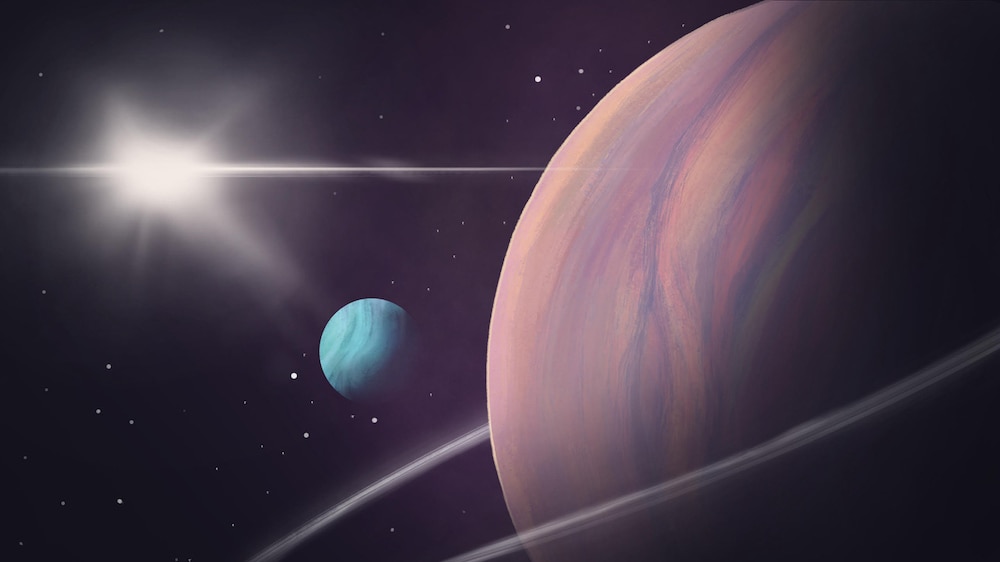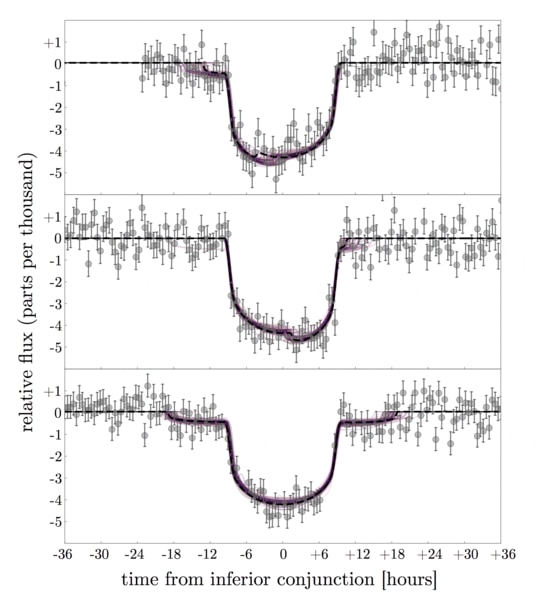Create a free profile to get unlimited access to exclusive videos, sweepstakes, and more!
Another candidate exomoon found: An alien moon orbiting an alien world!
If it exists the moon is far larger than Earth.

A team of astronomers combing through observations of exoplanets — alien worlds orbiting other stars — thinks they have found evidence for another exomoon, a moon orbiting one of those planets.
!!!!
The planet is called Kepler-1708b, and it orbits a star 5,500 light years away that looks very much like the Sun, if a tad bigger and brighter. The planet is about the same size as Jupiter but something like 4-5 times as massive. It orbits the star pretty far out, half again as far as the Earth orbits the Sun, so roughly 240 million kilometers or so. This means its orbital period is very long, 737 days, over 2 Earth years!
The moon, if it exists, is called Kepler-1708b-i, and would be about 2.6 times the diameter of Earth. That's pretty big for a moon! But it's also in line with the previously discovered exomoon candidate, Kepler-1625b-i, which — again, if it exists — is about the size of Neptune, four times the diameter of Earth,
Although we don't understand how moons this large can form, this actually makes me more confident these detections may be real: the biggest ones are the most likely to be found first. A similar thing happened with the first planets detected around Sun-like stars; they were hot Jupiters, huge gas giants orbiting very close in to their host stars, which makes them easier to find. Still, that was a surprise, as astronomers didn't think planets could form that close in. But then it was found they form farther out and migrate inward, solving the problem. If these exomoons are real and truly are this large, we'll have to figure out how they exist at all.
So how were they found?
The vast majority of exoplanets has been found using the transit method, where we see the planet's orbit edge-on, and once per orbit it passes directly in front of its star, creating a mini-eclipse. This dims the light a bit, so if we stare at enough stars for long enough and carefully measure their light we can find these planets.
If a planet has a moon, that will affect the observations. If the moon happens to be "ahead" of the planet in its orbit when the transit occurs we'll see a tiny transit before the main one; if it trails behind we'll see a dip after. It's likely the moon's and planet's transits overlap, so it gets complicated quickly.
This method has been used to look for exomoons before, which is how the candidate Kepler-1625b-i was found. For the new work (link to paper), the astronomers again used data from the planet-hunting Kepler spacecraft that pointed at a patch of sky in the constellation of Cygnus for four years, observing 150,000 stars for tell-tale exoplanet dips. It found thousands.
To maximize their chances, the astronomers looked for gas giant planets — big planets like Jupiter — in the data, because we know they can have lots of moons, and some can be very big and therefore easier to see. Ganymede, for example, is Jupiter's biggest moon, and it's larger then the planet Mercury! They also tuned their search for planets
decently far from their host star. If they're too close, the gravity of the star can perturb the moon's orbit, which can eject it.
They found 70 planets that matched these criteria and had clean enough transits to examine. They then examined the transit light curves — a graph of the star brightness versus time — to look for any dips that might have a moon in them.
They created lots of models of potential planet+moon transits, varying the sizes of the planets and moons, their mutual distance, and so on, and then compared these simulations to the real transits, using a series of very stringent tests and parameters to make sure they wouldn't get fooled by something that might look like a moon but was actually just noise.
In the end, only one planet, Kepler-1708b, passed all the tests. A pair of transits seen by Kepler both showed signs of an exomoon. In one, the moon — if it exists — started its transit just before the planet did, and it ends before the planet's transit does, causing a couple of bumps in the light curve. In the second one the moon transit starts just after the planet's.
The depth of the transit (how much light it blocked) is why they think the moon is so large. No moon anywhere near that size exists in our solar system, and it's hard to understand how such a big one could be formed. It's possible it started off as an independent planet around the star and was captured by the planet, or maybe it formed in the disk of material that the planet grew from.
Confirming this exomoon won't be easy. The planet's long orbital period means transits only happen once every two Earth years. A big 'scope would have to watch the star during the next scheduled transit, and probably for a day or so before and after to make sure it doesn't miss it. That's a tough proposal to make to an observatory. But if more of these candidates are found, the pitch gets easier.
After all, confirming the first known exomoon ever is a pretty nice trophy. Hopefully we won't have to wait too long before we get to award one.




























